Healthcare Workflow Automation 101: Reducing Bottlenecks and Friction
💡What are workflow bottlenecks in clinics?In disconnected systems, small handoff failures pile up and become huge delays. Manual re-entry, phone...
5 min read
Gregory Vic Dela Cruz : 8/31/25 3:00 PM

Revenue growth in healthcare often comes down to efficiency. Every missed appointment, delayed confirmation, or error in intake chips away at financial stability. Inefficiency had become a recurring challenge. Staff spent hours every week confirming appointments manually, juggling calls, and updating schedules. Not only did this drain resources, but it also limited how many patients the clinic could serve.
Recognizing that they needed a smarter system, the clinic turned to Curogram. By integrating patient communication with their existing EMR, the clinic automated appointment confirmations, reduced no-shows, and freed up staff capacity. The impact went beyond convenience—it created measurable gains in both patient care and clinic revenue.
This case study explores the clinic’s challenges, the approach taken with Curogram, and the results that show the hidden ROI of integration in action.
Before implementing Curogram, Covina Arthritic Clinic faced a problem common across specialty practices: manual appointment confirmations. Staff spent large portions of their day calling patients to confirm visits, leaving voicemails, and updating the EMR manually. This was both time-intensive and error-prone.
Administrative staff were tied up in repetitive tasks rather than focusing on patient support. Each confirmation call consumed several minutes, and with hundreds of patients each month, the hours quickly added up. This not only drove staff burnout but also slowed response times for patient inquiries.
With no automated reminders in place, no-shows became a consistent issue. Missed appointments directly reduced revenue, while empty slots left providers underutilized. For a specialty clinic, where each appointment represents high-value care, these gaps had an outsized impact on financial performance.
As the clinic grew, the manual system could not keep pace. Scaling appointment volume meant scaling staff effort, an unsustainable path for a practice looking to expand patient access without ballooning administrative costs.
The challenge was clear: They needed a scalable solution that would streamline confirmations, reduce no-shows, and protect staff time while increasing revenue capacity.
To solve these challenges, the clinic implemented Curogram’s integrated communication system. This approach replaced manual calls with automated appointment confirmations that synced directly with the EMR.
Curogram’s platform automatically sent appointment reminders and processed patient responses in real-time. Confirmations updated directly in the EMR, eliminating duplicate work for staff and reducing the risk of errors.
Patients could confirm, cancel, or reschedule appointments instantly via text. This two-way communication reduced phone tag and made it easier for patients to manage their care on their terms.
Because confirmations were now automated, the clinic could handle higher patient volume without adding administrative staff. Staff were redeployed to higher-value activities like patient support, improving overall service quality.
The seamless connection to the EMR ensured all data was accurate and up-to-date. Staff no longer needed to reconcile multiple systems or manually update schedules.
Within months, Covina Arthritic Clinic confirmed an average of over 1,100 appointments monthly, ensuring patient care and clinical revenue. Staff reclaimed hours each week, no-shows decreased, and operational efficiency improved dramatically.

For the clinic, integration wasn’t only about cutting manual work. It became a catalyst for better patient engagement, stronger loyalty, and improved financial performance. With Curogram, the clinic achieved measurable results that touched every part of the patient journey.
By automating appointment confirmations, Covina confirmed more than 1,100 visits each month, protecting provider schedules and revenue. No-shows dropped as reminders became reliable and actionable. Patients no longer missed messages or received conflicting information. Every confirmed slot translated into steady income for the clinic and better continuity of care for patients.
Previously, administrative staff spent hours daily on repetitive phone calls. With automation, those tasks disappeared. Appointment confirmations updated directly in the EMR without manual re-entry, freeing staff to focus on higher-value work. This reduction in busywork decreased burnout and improved morale. Staff could now spend time guiding patients, answering care-related questions, and supporting providers.
Curogram enabled patients to confirm, cancel, or reschedule appointments instantly via HIPAA-compliant 2-way texting. For many, texting was easier than answering a call during work hours or navigating a voicemail system. The convenience boosted satisfaction, particularly among working patients and caregivers managing multiple appointments. Patients felt empowered, knowing they had a simple, direct way to communicate with the clinic.
Integration also simplified intake. Patients received secure links to complete forms before their visit, upload insurance details, and share health histories:. This eliminated paperwork at the front desk, shortened check-in times, and reduced errors that often delayed billing. Providers began visits with accurate, legible information, improving efficiency during appointments and enabling better clinical decisions.
Post-visit surveys and review requests went out automatically, giving the clinic real-time insights into patient satisfaction. Negative feedback was flagged quickly, allowing staff to resolve issues before they escalated. Positive reviews boosted the clinic’s online presence, attracting new patients. What once required manual outreach became a seamless, automated loop of engagement and feedback.
According to Curogram’s patient engagement outcomes, practices using automated reminders often see a 30% reduction in no-shows, directly improving provider utilization and clinic revenue. The clinic mirrored these results. With fewer wasted slots, billing volume increased, and revenue climbed without adding staff or expanding hours.
Engagement tools like convenient messaging and pre-visit reminders created a more supportive experience for patients. They felt cared for from the moment they booked their appointment until after their visit. By reducing friction at every stage, the clinic built stronger relationships that improved retention. Patients were not only more likely to return but also to recommend the clinic to friends and family.
What made the transformation remarkable was its sustainability. The clinic didn’t just see temporary improvements—it built a system that scaled with growth. As patient volume increased, the integrated system handled the workload without adding staff. Efficiency and engagement became permanent features of the clinic’s operations, securing both financial stability and patient trust for the long term.
For Covina Arthritic Clinic, Curogram delivered more than revenue gains. It transformed how the clinic engaged patients, reduced administrative strain, and built a foundation for growth. This case shows that integration is both a financial strategy and a patient engagement strategy—one that pays off in measurable ROI and stronger care relationships.
Automating confirmations was the first step toward a more efficient, scalable practice. The clinic’s experience illustrates how integrated systems reduce no-shows, protect staff time, and create consistent revenue growth. In an environment where every appointment slot matters, integration delivers returns that manual processes never could.
Want to see how integration can transform your clinic? Schedule a demo with Curogram today to explore how automated reminders, two-way texting, and EMR integration can boost your efficiency and revenue.
Automated review requests generate steady positive feedback, improving visibility and trust with prospective patients.

💡What are workflow bottlenecks in clinics?In disconnected systems, small handoff failures pile up and become huge delays. Manual re-entry, phone...
.png)
💡The key to improve clinic efficiency lies in strategies that reduce admin burden. Doing so improves patient flow without hiring and increases...

💡 A small clinic fixed its biggest workflow bottlenecks by integrating communication with its EMR. Before: Staff spent hours on phones, patients...